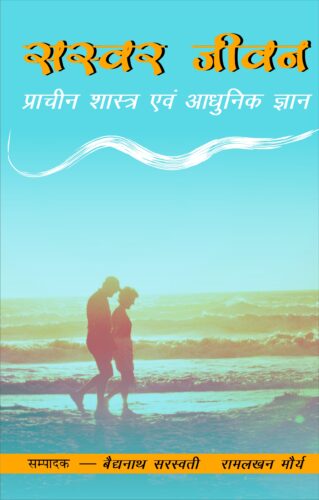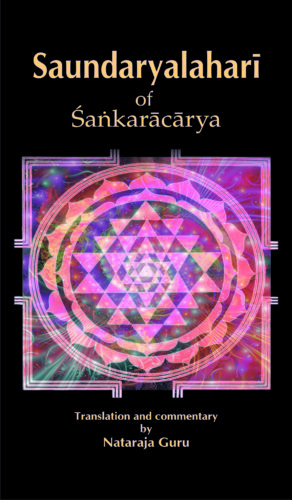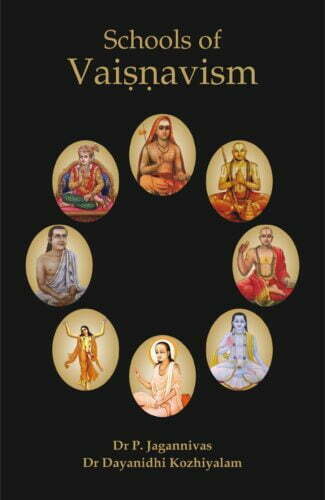Showing 781–790 of 1063 results

This book, the third volume in the Sanskrit Studies Series of JNU, addresses varied topics of Sanskrit studies such as the Theory of Oral Composition of Veda, Hermeneutics of the Upanisads, Concept of Dharma, Aesthetic Universe of Natyasastra, the Cultural Geography of Kalidasa, Sanskrit Commentary, Archaeoastronomy, Universal Premise in Early Nyaya, among others.
This anthology (2013-14) is the third volume of the Sanskrit Studies, a serial publication from the Special Centre for Sanskrit Studies, Jawaharlal Nehru University (JNU). The first volume of the series was published in 2004-05, and the second in 2006-07. JNU is committed to bring out this serial publication, though with some interval.
This Sanskrit Studies series is set to focus on a vast range of Sanskrit language and literature, grammar and historical linguistics, sources of history and systems of philosophy, principles of poetics and details of dramaturgy, lexicography, and so on. It also aims to bring forth the vision of Vedic texts and the varieties of Vedic traditions, Buddhist canons, Pali texts, different versions of Prakrt language and the emerging field of computational linguistics, thus adopting a multi-disciplinary approach.
This volume too deliberates on varied topics of Sanskrit studies and discusses the theory of Oral Ccomposition of Veda, the Yajusha Hautra Dispute, Hermeneutics of the Upanisads, Concept of Dharma, Aesthetic Universe of Natyasastra, the Cultural Geography of Kalidasa, Sanskrit Commentary, Archaeoastronomy, Universal Premise in Early Nyaya, Sanskrit and Tamil Interrelation, among others.
The fifteen articles presented in this volume represent the richness and rigour of Sanskrit studies in contemporary times across the globe. It should interest all those who are in Sanskrit studies researchers, teachers, students and scholars alike.

This fourth volume in Sanskrit Studies from JNU encompasses a vast range of Sanskrit disciplines including language, literature, grammar and philosophy of Sanskrit, and related disciplines like Pali, Prakrit and Apabhramsha studies, both traditional and modern subjects, showcasing the profound views of erudite scholars from India and abroad.
The fourth volume of Sanskrit studies (2015) is a consecutive publication of the Special Centre for Sanskrit Studies, Jawaharlal Nehru University. This publication from JNU is intended to throw the light on vast range of Sanskrit studies such as language and literature of Sanskrit, Grammar and linguistics, Vedanta and other ancient Indian Philosophies, Poetics, Dramaturgy, Historiography of Vedic Age, Purana and Dharmashastra, etc.
This anthology presents the profound views of experienced and young scholars from India and abroad. It addresses both traditional and modern systems prevailed in the area of Sanskrit Studies. Sanskrit is the source of great inspiration and treasure house of various knowledge systems. Its literature has spread the universal brotherhood and sustainable human relations in the world. Therefore Special Centre for Sanskrit Studies determined to bring out this publication in the field of Sanskrit Studies on vast range of Sanskrit disciplines which cover not only Language, Literature, Grammar and Philosophy of Sanskrit, but also the related disciplines such as Pali, Prakrit and Apabhramsha studies.
The seventeen articles in this volume fourteen in English and three in Sanskrit cover topics such as Champa in the Global Vision of Classical India; Kashmirs Contribution to Sanskrit Literature; Concept of Nirvikalpaka and Savikalpaka; Reconstructing Abhiramamani; Legend of King Nimi and Uttarakanda of Valmiki Ramayana; A Dense Definition of Rupaka; Abduction and Marriage in Ithihasa and Purana; Problem of Iron in Rigvedic Society; Ancient Indian Methodology of Authoring Textbooks; Bana: A Histographer; Vedantadarshne Brahmasvarupam; among others.
Sapiens and Sthitaprajna studies the concept of a wise person in the Stoic Seneca and in the Bhagavadgita. Although the Gita and Seneca’s writings were composed at least two centuries apart and a continent apart, they have much in common in recommending a well-lived life. This book describes how in both a wise person is endowed with both virtue and wisdom, is moral, makes right judgements and takes responsibility for actions. A wise and virtuous person always enjoys happiness, as happiness consists in knowing that one has done the right thing at the right time.
Both Seneca and the Gita demand intellectual rigour and wisdom for leading a virtuous and effective life. They provide guidelines for how to become and be wise. Both systems demand a sage to be emotionally sound and devoid of passions. This leads to mental peace and balance, and ultimately tranquillity and happiness. While surveying these similarities, this study also finds differences in their ways of application of these ideas. The metaphysics of the Gita obliges the sage to practise meditation, while the Stoics require a sage to be a rational person committed to analysing and intellectualizing any situation.
This comparative study will be of interest to students of both Ancient Western and Ancient Indian Philosophy. Practitioners of Stoicism and followers of the Gita should find the presence of closely-related ideas in a very different tradition of interest while perhaps finding somewhat different prescriptions a spur to action.

The book employs the multi-disciplinary methodologies of art historical interpretation to contextualise nearly the whole range of Saptamatrka icons within the larger historical evolution of accultured Brahmanical religion, mythology, theology and cultic developments.
The worship of Saptamatrika; the seven Mother Goddesses (or the seven Saktis, the divine feminine powers), is over a millennia and half old, pan-Indian phenomenon. And, over the centuries, the Matrika concept has come to have varied ideational, literary, visual and ritualistic manifestations which not just interconnect the totality of Brahmanical and non-Brahmanical religious traditions, but are integral components of the diverse historical processes of Indian society. A reputed scholar of art history here offers an insightful iconological study of Saptamatrika divinities: the Brahmanical goddesses found invariably as a single collective whole, consisting literally of seven (though sometimes eight or more) female deities, variably accompanied by different forms of Shiva, and Ganesha or Skanda. Employing the multidisciplinary methodo-logies of art historical interpretation, including the recent feminist interventions, Dr. Panikkars inquiry contextualises nearly the whole range of Saptamatrika icons within the larger historical evolution of accultured Brahmanical religion, mythology, theology and concomitant multifarious cultic developments. Also clarifying some of the basic principles of Brahmanical iconic tradition, his study has, for the first time, exceeded the accepted Art Historical procedures by incorporating the questions of class conflict, gender representations and ideology within the iconological discourse and has, thus, advanced the frontiers of Art Historical practice. It is a compelling, painstakingly researched work growing from the authors indepth survey of diverse Saptamatrika sculptures and an astonishing mass of both primary textual sources and research publications of more recent years. And, yet more significantly, it is enlivened with exquisite visual material: comprising nearly 200 photographic reproductions.

Sarada script has a pride of place among the Indian scripts. Though an alphabet of Kashmir par exellence, it remained for several centuries a popular script of north-western India and an extensive area around it. This book deals with the development of this script and its descendants, the Devasesaa and Takari scripts.
Among the Indian scripts the Sharada script has a pride of place. Though an alphabet of Kashmir par excellence it remained for several centuries a popular script of an extensive area of north-western India including Afghanistan, Gandhara or north-western Pakistan, the Darad territories of Gilgit, Chilas and Chitral, Ladakh, Jammu, Himachal Pradesh and Delhi. The epigraphic and literary records written in the Sharada script that have surfaced in these regions have thrown welcome light on many facets of the history and culture of the area of their provenance. Nearly the entire extant manuscripts of Sanskrit works including those on science, mathematics and erotics besides some old Kashmiri texts are written in this script. The Sharada alphabet was replaced in the 13th century by its descendant, the Devashesha, which in turn gave rise to the modern alphabet of Takari. The epigraphic, literary and other valuable documents of Himachal Pradesh available are mostly written in Devashesha and Takari. But it is sad that the number of scholars having a sound knowledge of the Sharada and Takari scripts is extremely small. There is every apprehension of the complete loss of these two scripts unless serious measures are taken to disseminate the knowledge under the guidance of the epigraphy stalwart to our younger generation of scholars. The entire study of the present work is based on original records and is comprehensively illustrated by palaeographic tables and charts prepared from published facsimilies, photographs, and original inscriptions and manuscripts. To give an idea of the records written in these two scripts, printed photographs of the inscriptions, manuscripts, documents, etc. have been given at the end of the book. It is hoped that the book would serve as a guide and an aid for the scholars interested in the study of the important and valuable records written in Sharada and Takari scripts which are otherwise preserved in museums and libraries in India and abroad.

This book explains the concept of life across different religions Þ Hindu, Buddhist, Jaina, Muslim and Christian Þ based on Shastras; life and its essence based on Upanisads, Gita, and other Shastric and Puranic teachings; and attempts to understand life in a scientific way with the help of modern science, along with the mysteries of life from various angles.
This book, divided into three parts, presents the independent thoughts of distinguished scholars on the satiety of life, its various styles and meanings in reference to religion and scriptures vis-à-vis modern science. The essays in the first part, based on the Shastras, try to explain the conception of life in Hindu, Buddhist, Jaina, Muslim and the Christian religions. The second part aims to understand the subject of Life and also to explain its essence on the basis of the Upanishads, Gita and other Shastric and Puranic teachings. The writings focus on, among other things, the mystery of life and death, the regularity of life, the effect of music on life, and the calculation of life on the basis of astrology. The third part (Modern Science) is a sincere attempt to understand life with a scientific approach. A logical explanation has been crafted on dependence on each other in life analyzing several literary references. This part discusses two aspects of life internal and external, life from a void to infinity, life being always out of bounds of time, life in a continuous flow of thoughts in Indian philosophy, etc. This anthology tries to explain the mysteries of life from various angles and will prove to be benefical to the researchers and students of Indian culture.

This detailed commentary views the Saundaryalahari compilation of 100 verses in praise of the Devi as Advaita Vedanta itself. The absolute joy of Advaita is presented in a pictorial language, subjectively as ananda, and objectively as saundarya.
The Saundaryalahari has fascinated and puzzled generations of scholars and laypersons; subject to continuing study and debate, till today, such details as the authorship of the 100 verses named the Saundaryalahari remain a matter of contention, particularly among scholars. While some attribute it to Shankara, others argue that the Saundaryalahari’s verses in praise of the Devi cannot have been authored by this staunch Vedantin; some argue that its value is essentially in the realm of what is loosely called “tantra,” while others extend the significance of the Saundaryalahari to include the preoccupations of Vedanta. Nataraja Guru is unequivocal in his belief that none other than Shankara could have composed this masterpiece of mystical poetry and identifies internal evidence in the verses themselves to support this view. The detailed commentary views the Saundaryalahari as Advaita Vedanta itself. The absolute Joy of Advaita is presented in a pictorial language, subjectively as ananda, and objectively as saundarya.

It is a comprehensive study of the life and works of Sayyid Abul ÿasan `Ali Nadwã, an important scholar of his time with significant contribution to contemporary Islamic thought, discussing his major writings concerned with the themes like primacy of the Qur’àn and the sunnah as harbingers of world civilisation.
The volume presents a comprehensive study of the life and works of Sayyid Abul Hasan Ali Nadwi (1913-1999). Sayyid Abul Hasan Ali Nadwi is seen as an important scholar in the modern Islamic resurgence who has made significant contributions to contemporary Islamic thought. He was one of the few Indian ulama to have taken seriously the dynamic role of Islam in a multi-religious society. The book discusses the early life, family and education of the scholar and his major writings that are concerned with the themes of the primacy of the Quran and the sunnah as harbingers of world civilisation, ishlah (reform) and tajdid (revival) as anchors of Islamic resurgence, the methodological approach of dawah, Islam and the West, and Islamic order in an Indian setting. With quotations and references from published translations of his Urdu and Arabic works including his autobiography, it details the importance of his coherent approach to the diversity of issues in the twentieth century and the importance of his autobiography Karwan in this context. It deals with his participative role in the Indian mainstream activities, examining the social and spiritual crises facing Muslims. With an overview of contemporary Islamic movements, it takes up his relationship with and contribution to the Tabligh Jamaat, a global movement founded by Mawlana Ilyas noted for its reformist trends.
The book will undoubtedly be of interest to scholars and students of Islamic studies.

The book provides a detailed study of the Vaisnava acaryas such as Sri Ramanuja, Sri Nimbarka, Sri Madhvacarya, Sri Caitanya, Sri Vallabha, Sri Sankaradeva and Sri Swami Narayana and their religious philosophies vis-à-vis Sri Sankara’s jnana theory.
The book provides a detailed study of the acaryas such as Sri Sankara, Sri Ramanuja, Sri Nimbarka, Sri Madhvacarya, Sri Caitanya, Sri Vallabha, Sri Sankaradeva and Sri Swami Narayana and their philosophies. The schools of Vaisnavism belonging to these venerable acaryas primarily promulgate for the seeker an alternate method which emphasizes that samsara is real, liberation is real, and worship and meditation are equally real, not mock battles. God is accepted as the Ultimate Reality – merciful and gracious, the seat of all auspicious attributes – by whose grace alone one can be freed from the bondage of samsara. These schools are well established in the Vedas and do not make a distinction between the Absolute (Brahman) and God (ISvara) or equate jiva with Brahman. Most of these schools, identify ISvara or Brahman with Visnu, who has a particular form (Catur-Bhujam, Sanku-Cakra, etc.) which distinguishes Him from other gods. All the acaryas of the schools of Vaisnavism had Lord Mahavisnu as the Supreme Reality, but for each one of them the Lord presented Himself in a different form. For example, for Sri Ramanuja, it was Sriman Narayana, for Sri Nimbarka, Sri Vallabha and Sri Caitanya it was Sri Krsna and for Sri Ramananda it was Sri Rama.
This volume should invoke keen interest in the philosophical community and among the followers of Vaisnava Sampradaya, along with a wide range of students, researchers and teachers of all religious philosophies.
| There are no products |